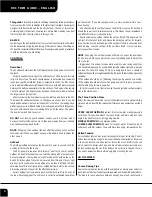
35
MONTEREY
BOATS
Operation
• Never spray swimmers, boats, rafts or other
skiers. The risk for a collision makes this dan-
gerous for the skier and people being sprayed.
• Some lakes have an approved tow pattern for
skiing. Always make sure to follow the pattern
on these lakes.
• Never follow directly behind another boat while
pulling skiers. Always stay a safe distance be-
hind or off the side of other boat traffic. If the
boat you are following stops unexpectedly, you
may not be able to respond quick enough endan-
gering your skier and occupants of both boats.
• Never follow behind another boat pulling a skier
for any reason, even if you are not pulling a skier.
If the skier you are following falls, you may not
be able to respond quick enough and could run
over the skier.
• When pulling multiple skiers, make sure the
ropes are the same length. Never pull multiple
skiers with tow ropes of different length
• Always make sure to slowly pull the slack out of
the ski rope and wait for the OK from the skier
before advancing the throttle to ensure the rope
is not wrapped around the skier and that the
skier is ready. Never advance the throttle until
the skier provides the ready signal.
• When turning around to pick up a fallen skier,
make sure to look for other boat traffic in the
direction of the turn before you turn the boat.
• Approach a skier in the water from the down-
wind side and be certain to stop the motion of
the boat and your motor before coming in close
proximity to the skier.
• Give immediate attention to a fallen skier. A
fallen skier is very hard to see by other boats
and is extremely vulnerable. When a skier falls,
be prepared to immediately turn the boat and
return to the skier.
• Never leave a fallen skier alone in the water
for any reason and have an observer display a
skier down flag to alert other boaters that your
skier has fallen.
• Agree on hand signals to be used between the
observer and skier to communicate. This is
important to eliminate confusion and ensure the
safety of your skiers, wakeboarders or tubers.
Refer the Hand Signals drawing in this section
for signals that are commonly used during water
sports activities.
• Make sure the observer watches for the skier’s
signal to indicate he or she is OK. If the signal
is not seen immediately, assume the skier is
injured and in need of immediate assistance.
Be prepared to respond quickly.
• For additional information on water skiing, in-
cluding hand signals and water skiing manuals,
contact the American Water Skiing Association
in Winter Haven, Florida, 813-324-4341.
WARNING
MOVING PROPELLERS ARE DANGEROUS. THEY CAN
CAUSE DEATH, LOSS OF LIMBS, OR OTHER SEVERE INJURY.
DO NOT USE THE SWIM PLATFORM OR SWIM LADDER
WHILE THE ENGINE IS RUNNING. STOP THE ENGINE IF
DIVERS, SWIMMERS OR SKIERS ARE ATTEMPTING TO
BOARD. ALWAYS PROPERLY STORE THE LADDER BEFORE
STARTING THE ENGINE.
2.12 Wake/Teak Surfing
Wake or Teak Surfing is a new and dangerous
boating fad that involves an individual holding
on to the swim platform of a vessel while a wake
builds up then lets go to body surf the wave cre-
ated by the boat; hence the term- “Wake Surfing.”
This activity puts that individual directly in the
path of the boat’s exhaust and poisonous carbon
monoxide. Because of the multiple dangers asso-
ciated with wake surfing and the carbon monoxide
problem in particular, the Coast Guard has issued
a safety alert that strongly advises the public not
to engage in wake surfing and warns that the
activity may cause carbon monoxide poisoning
and even fatalities.
Wake surfing not only exposes an individual to
potentially fatal concentrations of carbon mon-
oxide from the engine exhaust, it exposes them
unnecessarily and dangerously to the boat’s
propeller. The danger is compounded by the fact
that individuals do not usually wear a life jacket
when wake surfing.
Wake surfing is an extremely dangerous activity
and you should never allow anyone to “Wake Surf”
behind your boat or be in the water near the ladder
or swim platform while the engine is operating.
Summary of Contents for 378SE
Page 1: ......
Page 2: ...2 MONTEREY BOATS...
Page 4: ...4 MONTEREY BOATS NOTES...
Page 27: ...27 MONTEREY BOATS Operation...
Page 38: ...38 MONTEREY BOATS NOTES...
Page 56: ...56 MONTEREY BOATS NOTES...
Page 62: ...62 MONTEREY BOATS NOTES...
Page 88: ...88 MONTEREY BOATS NOTES...
Page 128: ...128 MONTEREY BOATS NOTES...
Page 138: ...138 MONTEREY BOATS NOTES...
Page 152: ...152 MONTEREY BOATS NOTES...
Page 159: ...159 MONTEREY BOATS Appendix A Hours Date Dealer Service Repairs Maintenance Log...
Page 160: ...160 MONTEREY BOATS Maintenance Log Hours Date Dealer Service Repairs...
Page 161: ...161 MONTEREY BOATS Maintenance Log Hours Date Dealer Service Repairs...
Page 162: ...162 MONTEREY BOATS Maintenance Log Hours Date Dealer Service Repairs...
Page 164: ...164 MONTEREY BOATS NOTES...
Page 165: ...165 MONTEREY BOATS Boating Accident Report Appendix C...
Page 166: ...166 MONTEREY BOATS Boating Accident Report...
Page 167: ...167 MONTEREY BOATS Boating Accident Report...
Page 168: ...168 MONTEREY BOATS NOTES...
Page 174: ...174 MONTEREY BOATS CAUSE AND SOLUTION NOTES...
Page 182: ...182 MONTEREY BOATS NOTES...
Page 184: ...184 MONTEREY BOATS Schematics Sureshade Harness SP SC 115 CONDUIT...
Page 192: ...192 MONTEREY BOATS Schematics 12V Engine Hatch Harness...
Page 198: ...198 MONTEREY BOATS Schematics 120V Hull Harness 54 24 24 30 6 6 6 6 48 MDP3 MDP4 88...
Page 200: ...200 MONTEREY BOATS NOTES...
Page 202: ...202 MONTEREY BOATS NOTES...
Page 208: ......
Page 209: ......
Page 210: ......















































